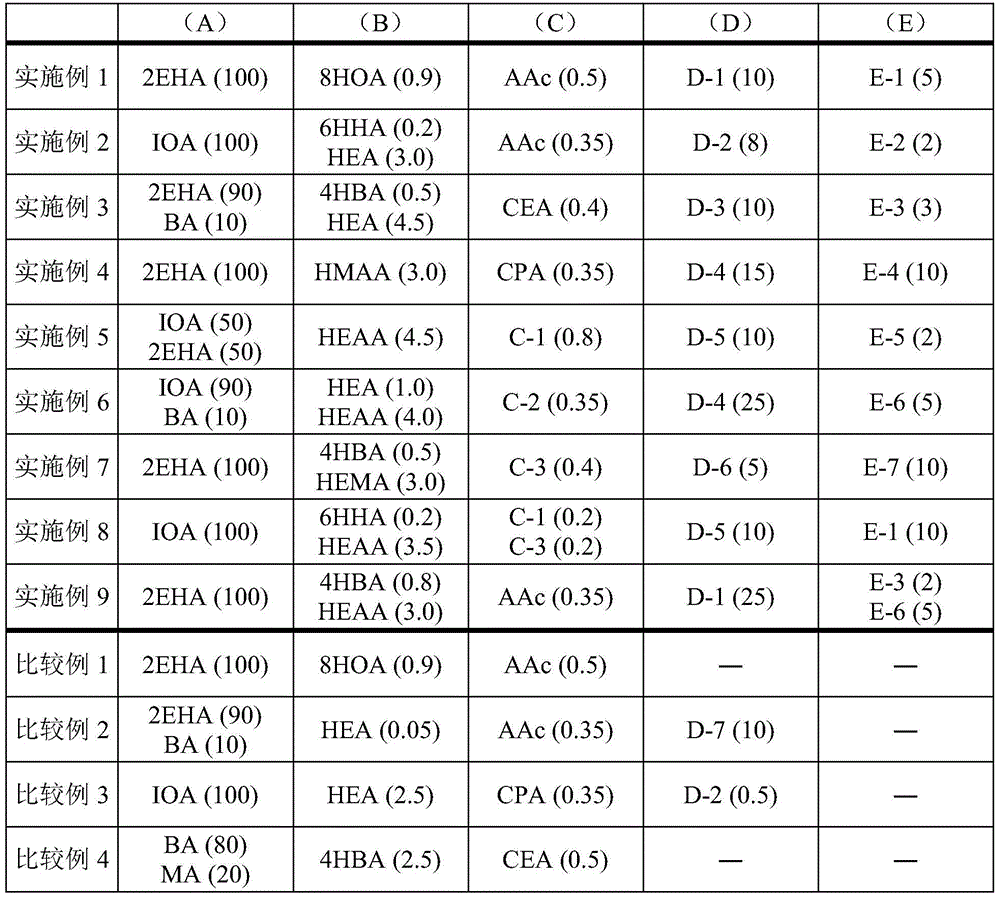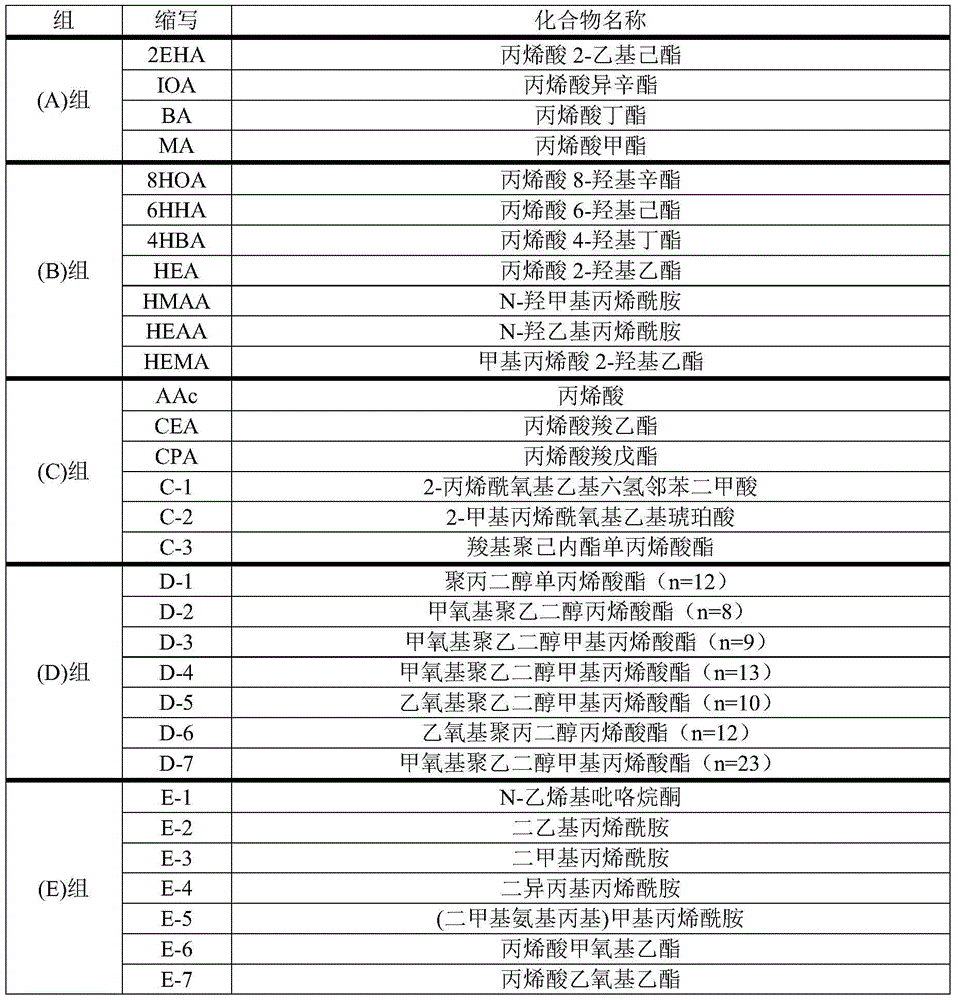Adhesive composition and surface protection film
A composition and adhesive technology, applied in the direction of adhesives, adhesive types, ester copolymer adhesives, etc., can solve the problems of easy reduction in reworkability, adhesive residue, and difficulty in peeling, etc., to reduce additives Amount, improve the performance of preventing adhesive residue, good effect of antistatic function
- Summary
- Abstract
- Description
- Claims
- Application Information
AI Technical Summary
Problems solved by technology
Method used
Image
Examples
Embodiment 1
[0121] Nitrogen gas was introduced into a reaction apparatus equipped with a stirrer, a thermometer, a reflux condenser, and a nitrogen introduction pipe, thereby replacing the air in the reaction apparatus with nitrogen. Then, added the 2-ethylhexyl acrylate of 100 weight parts, the 8-hydroxyoctyl acrylate of 0.9 weight part, the acrylic acid of 0.5 weight part, the polypropylene glycol monoacrylate of 10 weight parts The average repeating number of alkylene oxide of the alkyl diol chain (n=12), 5 parts by weight of N-vinylpyrrolidone, and 60 parts by weight of solvent (ethyl acetate) were added at the same time. Then, 0.1 parts by weight of azobisisobutyronitrile as a polymerization initiator was dropped over 2 hours, and reacted at 65° C. for 6 hours to obtain acrylic acid used in Example 1 with a weight average molecular weight of 500,000. Copolymer Solution 1. A part of the acrylic copolymer was used as a sample for acid value measurement described later.
Embodiment 2~9 and comparative example 1~4
[0123] Except that the composition of each monomer was adjusted as described in (A) to (E) in Table 1, the above-mentioned acrylic copolymer solution 1 used in Example 1 was operated in the same manner to obtain the 2-9 and the acrylic acid copolymer solutions in Comparative Examples 1-4.
[0124] Table 1
[0125]
[0126]
[0127] [Example 1]
[0128] To the acrylic copolymer solution 1 of Example 1 manufactured as described above, 2.5 parts by weight of acetylacetone was added and stirred, and then 1.0 parts by weight of Coronate HX (Coronate HX, isocyanuric acid of a hexamethylene diisocyanate compound) was added. ester), 0.2 parts by weight of Coronate L (the adduct of Coronet L, toluene diisocyanate compound and trimethylolpropane), 0.02 parts by weight of dioctyltin dilaurate and then stirred and mixed to obtain the binder combination of Example 1 thing. This adhesive composition was coated on a release film composed of a polyethylene terephthalate (PET) film coa...
Embodiment 11
[0166] Nitrogen gas was introduced into a reaction apparatus equipped with a stirrer, a thermometer, a reflux condenser, and a nitrogen introduction pipe, thereby replacing the air in the reaction apparatus with nitrogen. Then, added the 2-ethylhexyl acrylate of 100 weight parts, the 8-hydroxyoctyl acrylate of 0.9 weight part, the acrylic acid of 0.5 weight part, the polypropylene glycol monoacrylate of 10 weight parts The average repeating number of the alkylene oxide of the alkyl diol chain is n=12), 5 parts by weight of N-vinylpyrrolidone, and 60 parts by weight of solvent (ethyl acetate) were added at the same time. Then, 0.1 parts by weight of azobisisobutyronitrile as a polymerization initiator was dropped over 2 hours, and reacted at 65° C. for 6 hours to obtain acrylic acid used in Example 1 with a weight average molecular weight of 500,000. Copolymer Solution 1. A part of the acrylic copolymer was taken and used as a sample for acid value measurement described later....
PUM
| Property | Measurement | Unit |
|---|---|---|
| melting point | aaaaa | aaaaa |
Abstract
Description
Claims
Application Information
 Login to View More
Login to View More - R&D
- Intellectual Property
- Life Sciences
- Materials
- Tech Scout
- Unparalleled Data Quality
- Higher Quality Content
- 60% Fewer Hallucinations
Browse by: Latest US Patents, China's latest patents, Technical Efficacy Thesaurus, Application Domain, Technology Topic, Popular Technical Reports.
© 2025 PatSnap. All rights reserved.Legal|Privacy policy|Modern Slavery Act Transparency Statement|Sitemap|About US| Contact US: help@patsnap.com



